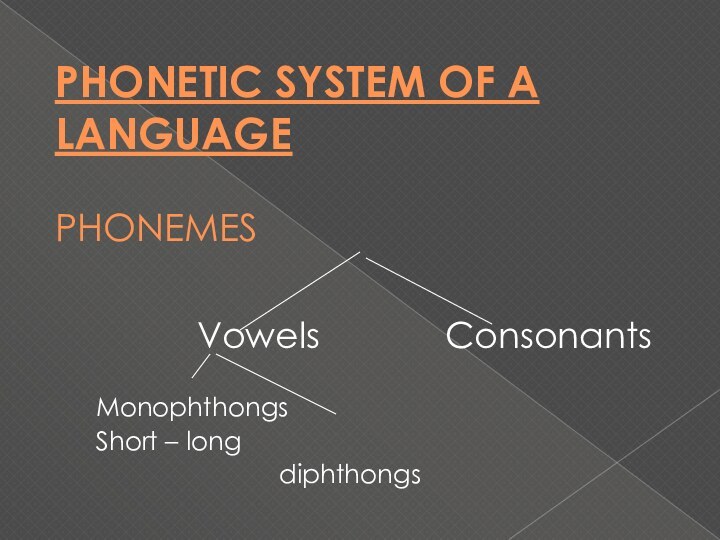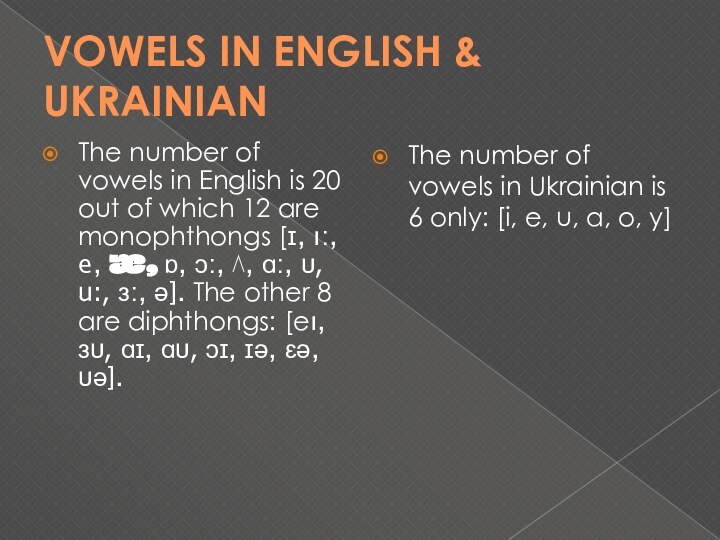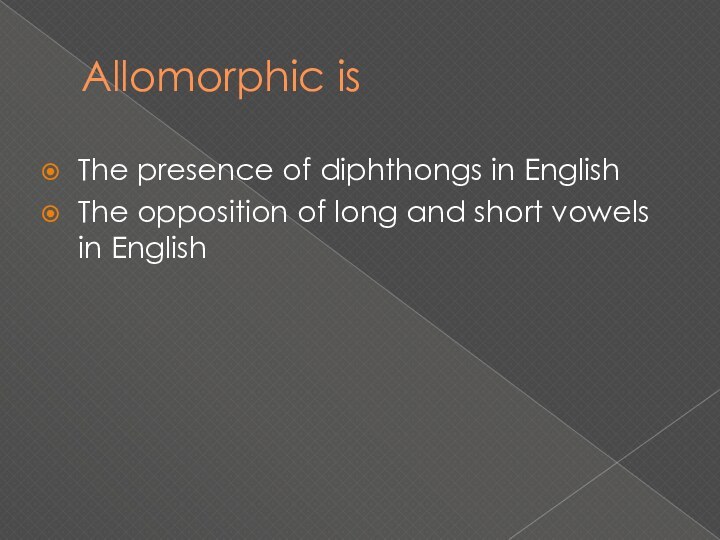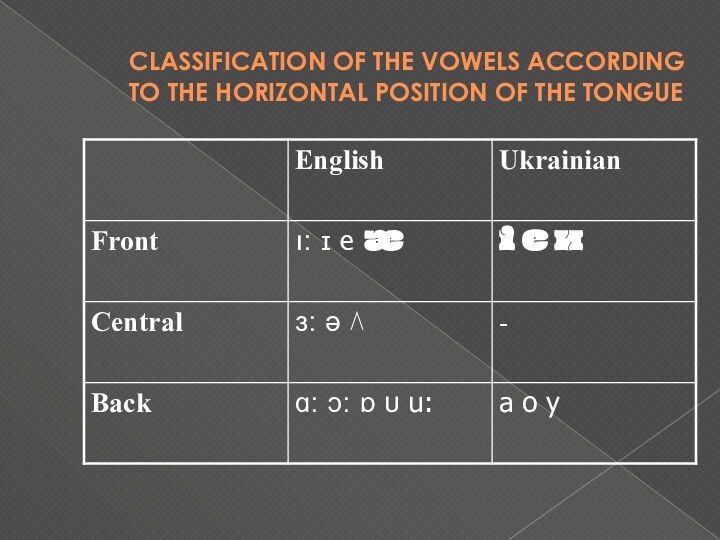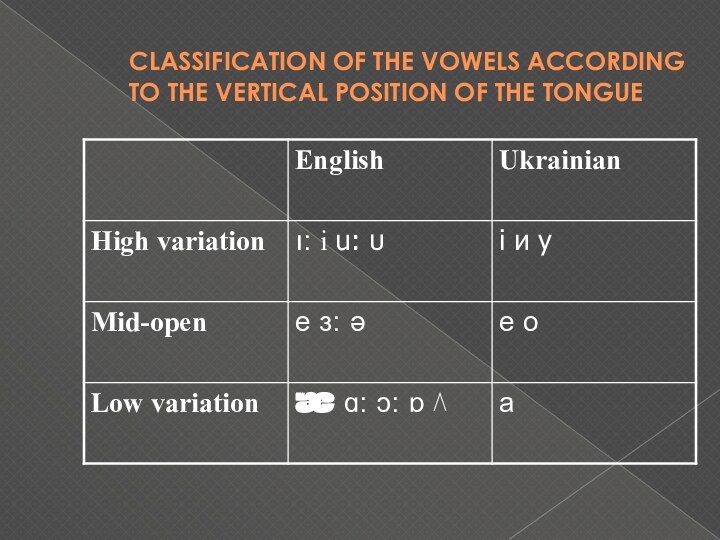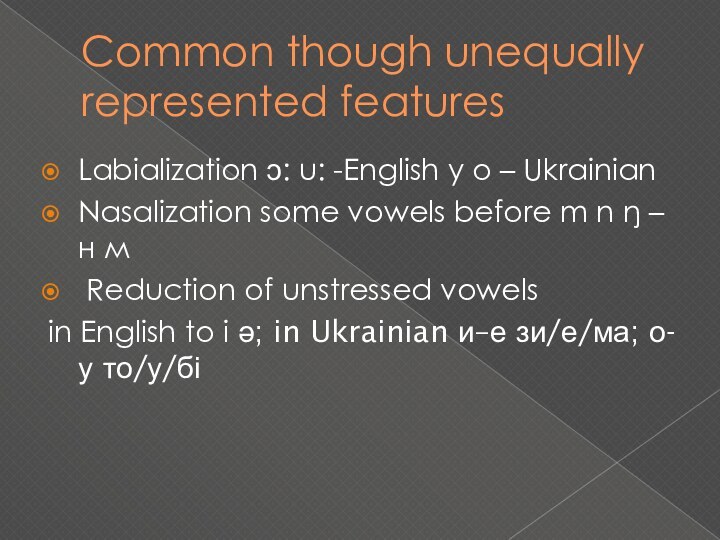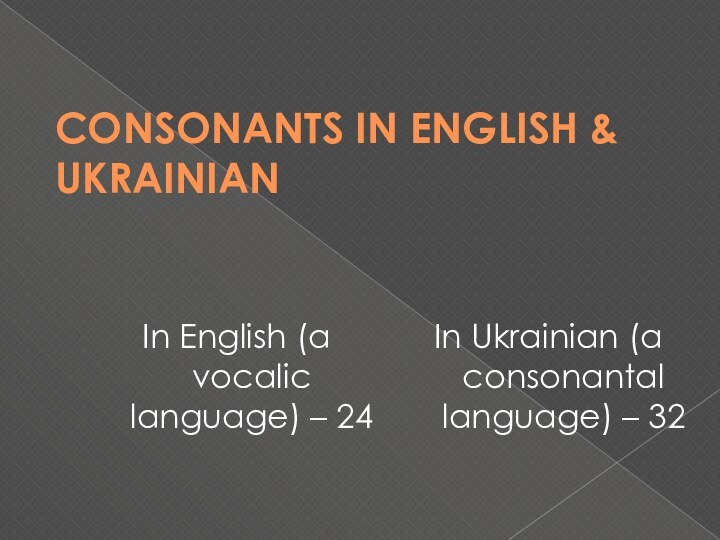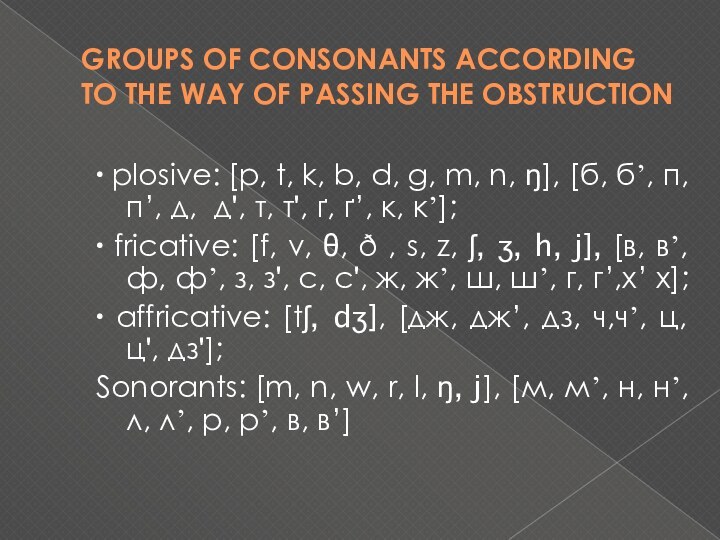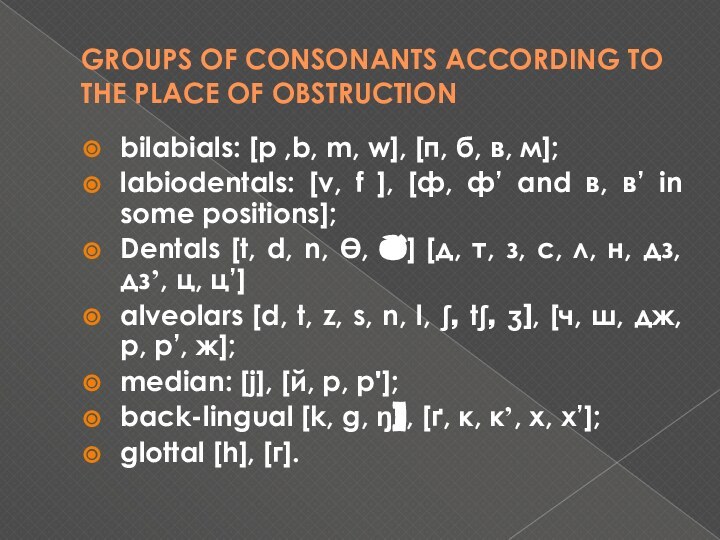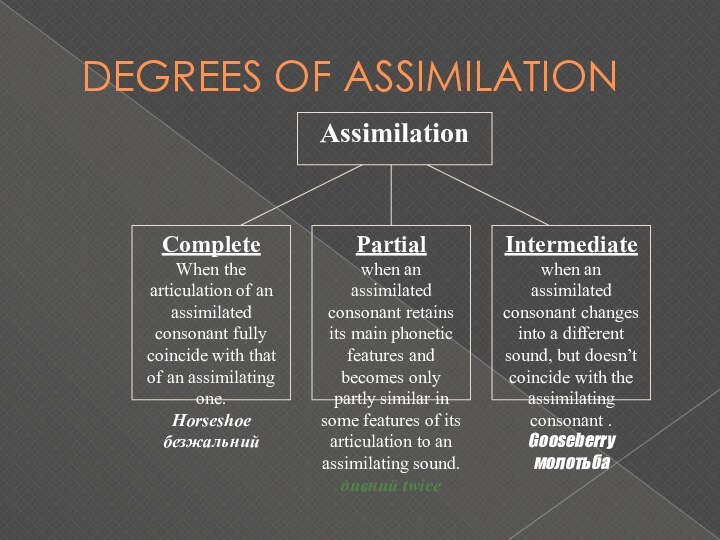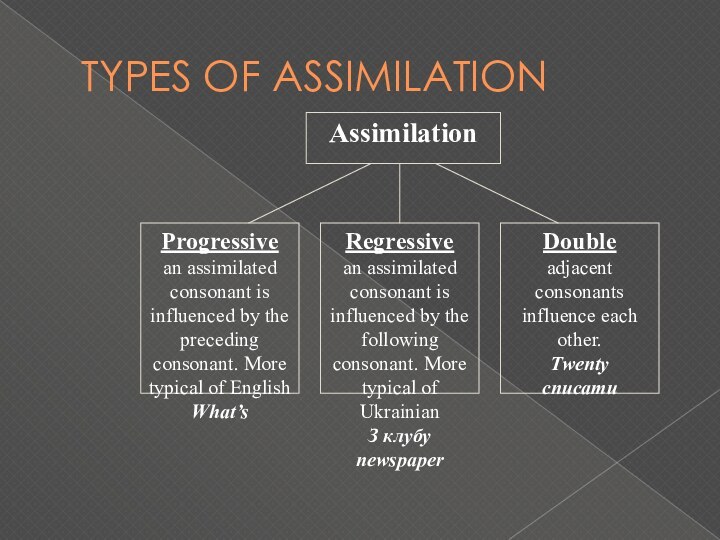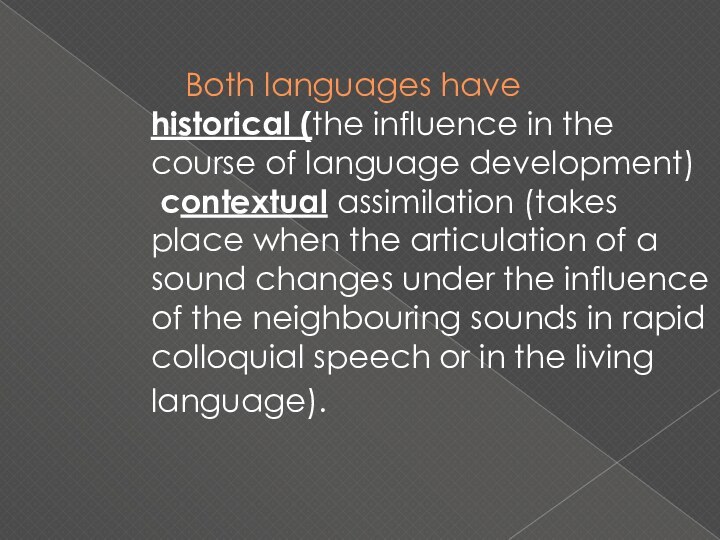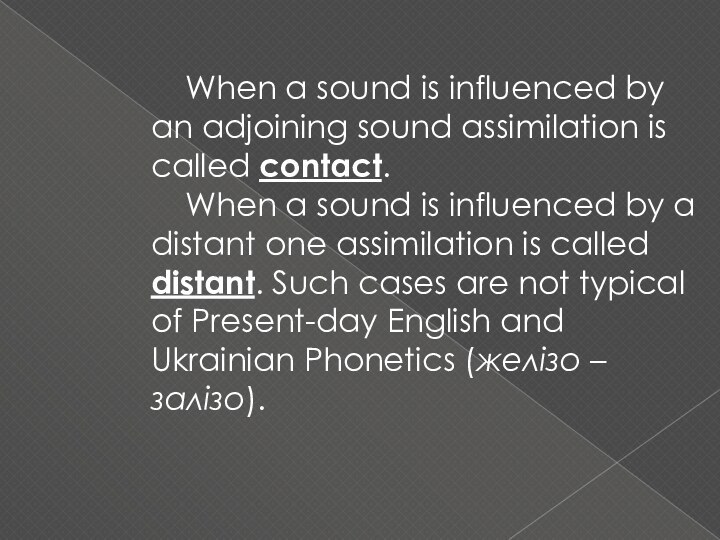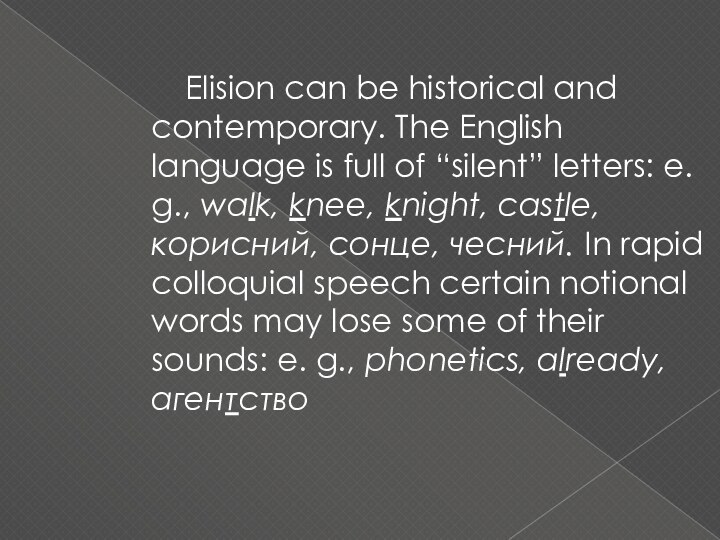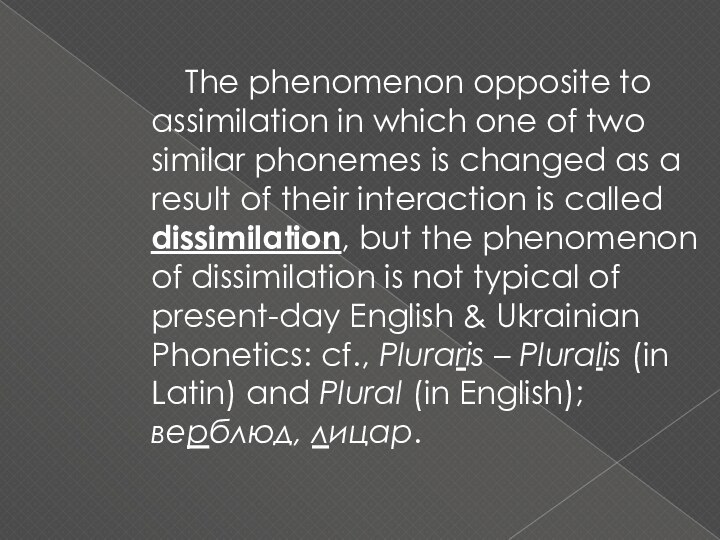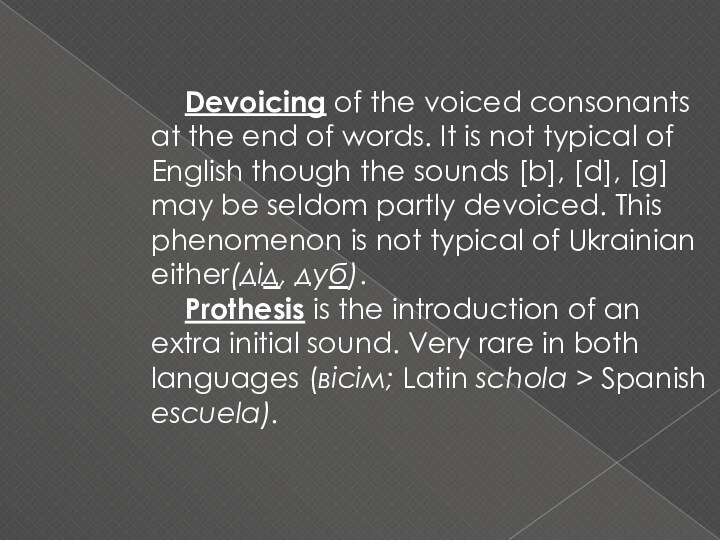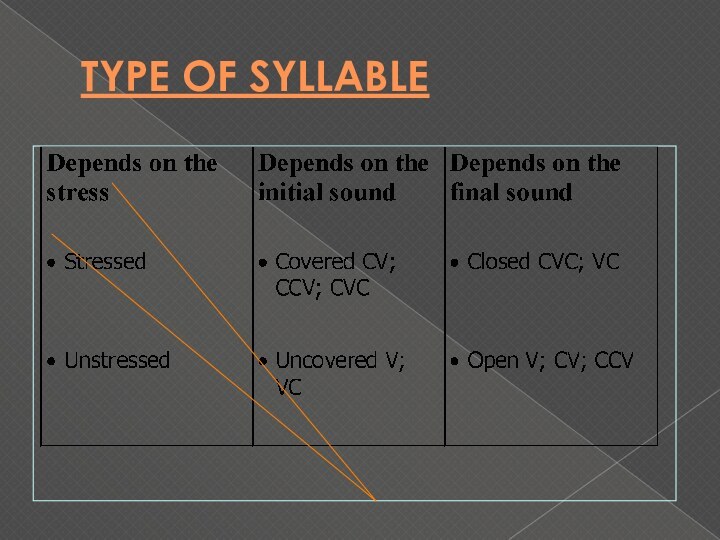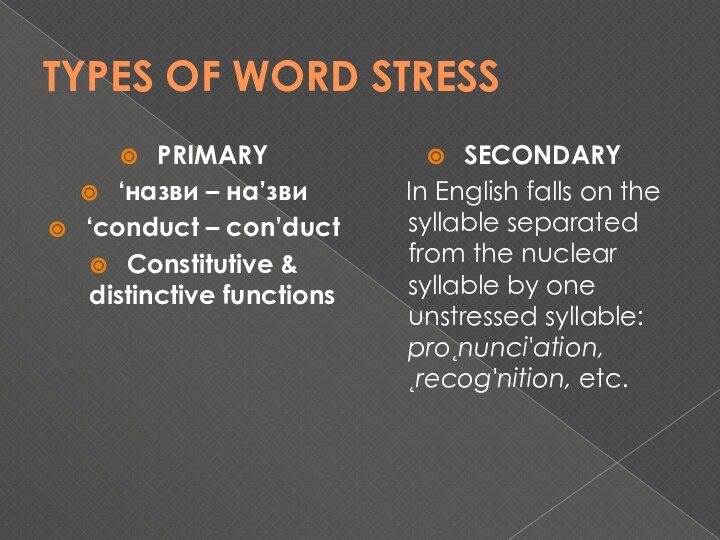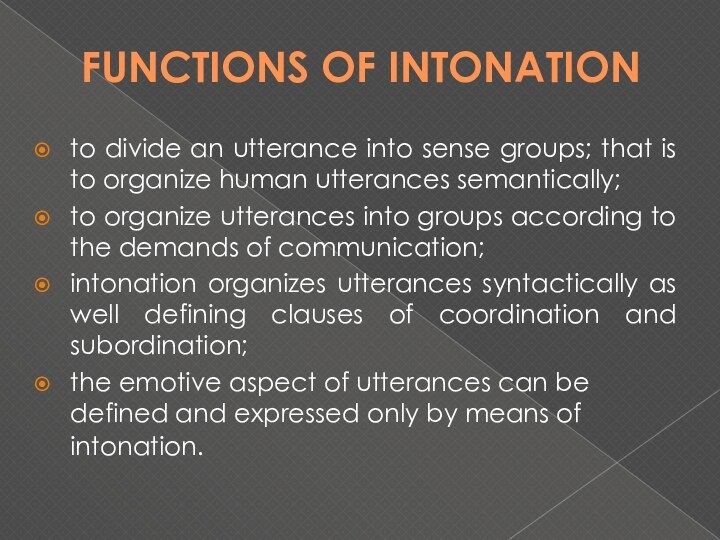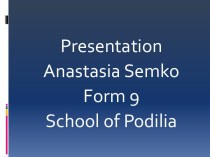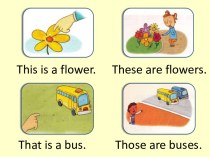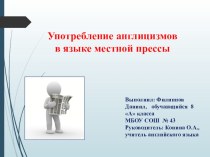Слайд 2
Lecture.
Typology of Phonetic and Phonological Systems of English
& Ukrainian.
Outline.
Typology of the Vowel Systems.
Typology of the Consonant
Systems.
Articulatory transitions in English and Ukrainian Speech.
The syllable in English and Ukrainian.
Word-stress and Utterance Stress.
English and Ukrainian Intonation.
Слайд 3
PHONETIC SYSTEM OF A LANGUAGE
PHONEMES
Vowels
Monophthongs
Short – long
diphthongs
Consonants
Слайд 4
VOWELS IN ENGLISH & UKRAINIAN
The number of vowels
in English is 20 out of which 12 are
monophthongs [ɪ, ı:, e, æ, ɒ, ɔ:, ⋀, ɑ:, υ, u:, ɜ:, ə]. The other 8 are diphthongs: [eı, ɜυ, ɑɪ, ɑυ, ɔɪ, ɪə, ɛə, υə].
The number of vowels in Ukrainian is 6 only: [i, e, u, a, o, y]
Слайд 5
Allomorphic is
The presence of diphthongs in English
The opposition
of long and short vowels in English
Слайд 6
CLASSIFICATION OF THE VOWELS ACCORDING TO THE HORIZONTAL
POSITION OF THE TONGUE
Слайд 7
CLASSIFICATION OF THE VOWELS ACCORDING TO THE VERTICAL
POSITION OF THE TONGUE
Слайд 8
Common though unequally represented features
Labialization ɔ: u: -English
y o – Ukrainian
Nasalization some vowels before m n
ŋ – н м
Reduction of unstressed vowels
іn English to i ə; in Ukrainian и–е зи/е/ма; о-у то/у/бі
Слайд 9
CONSONANTS IN ENGLISH & UKRAINIAN
In English (a vocalic
language) – 24
In Ukrainian (a consonantal language) – 32
Слайд 10
PALATALIZATION
is absent from English which has 4 soft
consonants tʃ, dʒ, ʃ, ʒ
is a typologically distinct feature
helping to differentiate lexemes in Ukrainian: син - синь
Слайд 11
GROUPS OF CONSONANTS ACCORDING TO THE WAY OF
PASSING THE OBSTRUCTION
∙ plosive: [p, t, k, b, d,
g, m, n, ŋ], [б, б’, п, п’, д, дʹ, т, тʹ, ґ, ґ’, к, к’];
∙ fricative: [f, v, θ, ð , s, z, ʃ, ʒ, h, j], [в, в’, ф, ф’, з, зʹ, с, сʹ, ж, ж’, ш, ш’, г, г’,х’ х];
∙ affricative: [tʃ, dʒ], [дж, дж’, дз, ч,ч’, ц, цʹ, дзʹ];
Sonorants: [m, n, w, r, l, ŋ, j], [м, м’, н, н’, л, л’, р, р’, в, в’]
Слайд 12
GROUPS OF CONSONANTS ACCORDING TO THE PLACE OF
OBSTRUCTION
Allomorphic features
interdental [ð, θ]
Post-alveolar r
Слайд 13
GROUPS OF CONSONANTS ACCORDING TO THE PLACE OF
OBSTRUCTION
bilabials: [p ,b, m, w], [п, б, в, м];
labiodentals:
[v, f ], [ф, ф’ and в, в’ in some positions];
Dentals [t, d, n, Ө, ð] [д, т, з, с, л, н, дз, дз’, ц, ц’]
alveolars [d, t, z, s, n, l, ʃ, tʃ, ʒ], [ч, ш, дж, р, р’, ж];
median: [j], [й, р, рʹ];
back-lingual [k, g, ŋ], [ґ, к, к’, х, х’];
glottal [h], [г].
Слайд 14
Assimilation is a phonetic process when two adjacent
consonants within a word or at word boundaries influence
each other in such a way that the articulation of one sound becomes similar or even identical with the articulation of the other one.
Слайд 17
Both languages have
historical (the influence in the course
of language development)
contextual assimilation (takes place when
the articulation of a sound changes under the influence of the neighbouring sounds in rapid colloquial speech or in the living language).
Слайд 18
When a sound is influenced by an adjoining
sound assimilation is called contact.
When a sound is influenced
by a distant one assimilation is called distant. Such cases are not typical of Present-day English and Ukrainian Phonetics (желізо – залізо).
Слайд 19
ACCOMMODATION
is an isomorphic phenomenon though more
important in English:
Tall - тонкий – labialized t/т
Слайд 20
Elision can be historical and contemporary. The English
language is full of “silent” letters: e. g., walk,
knee, knight, castle, корисний, сонце, чесний. In rapid colloquial speech certain notional words may lose some of their sounds: e. g., phonetics, already, агентство
Слайд 21
The omission of certain syllables is called haplology,
rare in English (Englalond > England), but spread in
Ukrainian (мінералологія - мінералогія, трагікокомедія - трагікомедія).
The same concerns metathesis – the change of syllables / sounds within a word (суворий, намисто, ведмідь, бондар; third > ðridda).
Слайд 22
The phenomenon opposite to assimilation in which one
of two similar phonemes is changed as a result
of their interaction is called dissimilation, but the phenomenon of dissimilation is not typical of present-day English & Ukrainian Phonetics: cf., Pluraris – Pluralis (in Latin) and Plural (in English); верблюд, лицар.
Слайд 23
Substitution results in the use of a
sound typical of a particular language instead of the
resembling sound of another language (тези – міф, архів).
Epenthesis is the addition of an alien sound into the existing sound complex: e. g., the French word advantage is changed into the English word advantage; ofn > ofen > oven; павук, Іспанія.
Слайд 24
Devoicing of the voiced consonants at the end
of words. It is not typical of English though
the sounds [b], [d], [g] may be seldom partly devoiced. This phenomenon is not typical of Ukrainian either(дід, дуб).
Prothesis is the introduction of an extra initial sound. Very rare in both languages (вісім; Latin schola > Spanish escuela).
Слайд 25
TYPES OF REDUCTION
observed in both languages
ZERO
the omission
of
a vowel
or a consonant.
Слайд 27
A SYLLABLE
OPEN
open syllables (are, ear, а-раб);
open covered syllables
(we, play, ми, два).
CLOSED
closed syllables (art, act,
ось).
Слайд 28
SYLLABLE FORMATION & SYLLABLE DIVISION
Vowels are syllable forming
in UL & EL.
Sonorants (m, n, l) in the
final position preceded by a consonant are syllable forming in EL
Short vowels are found in closed syllables only in EL (cut, look, potter)
Long vowels are found in both open and closed syllable (lead, Far-mer)
Слайд 29
Word-stress as singling out one or more syllables
in a word
English word stress is dynamic with the
tonetic component.
It is free.
English rhythm is stress-timed.
Ukrainian word stress is dynamic with the duration component.
It is free.
Ukrainian rhythm is syllable-timed.
Слайд 31
TYPES OF WORD STRESS
PRIMARY
‘назви – на’зви
‘conduct – con’duct
Constitutive
& distinctive functions
SECONDARY
In English falls on the
syllable separated from the nuclear syllable by one unstressed syllable: pro˛nunci'ation, ˛recog'nition, etc.
Слайд 32
WORDS WITH TWO STRESSES
ENGLISH
Compound adjectives and nouns:
'well-'known, 'absent–'minded, ‘abo’lition etc.
Composite verbs also have two primary
stresses, e. g., to 'get 'up, to 'give a'way, etc.
Words with the prefixes: un-, in-, dis-, sub-, ex-, under-, re-.
UKRANIAN
Such cases are optional: за′гальноос’вітній, ко′ристолю’бивий.
Слайд 33
INTONATION
Intonation is a complex unity of
speech melody, sentence stress, tempo, pausation, and timbre.


